Market Structure and Strategy: McDonald's and KFC Comparison
VerifiedAdded on 2022/11/14
|14
|3855
|452
Report
AI Summary
This report provides an in-depth analysis of the market structure within which McDonald's and KFC operate, specifically focusing on their oligopolistic nature within the fast-food industry. The study compares these two industry leaders to competitors like Starbucks, Burger King, Subway, and Dunkin' Donuts, evaluating their pricing, non-pricing strategies, and market share using both primary and secondary data, alongside the Herfindahl-Hirschman Index. The report highlights McDonald's dominance and recommends that KFC enhance product differentiation and utilize a mix of pricing and non-pricing strategies, such as price mimicking and status quo approaches, to expand its market presence. The analysis incorporates both Demand and Supply theory and the global market comparative advantage theory to assess market trends. The report also explores the growth strategies employed by McDonald's and KFC, including market penetration and product differentiation, respectively. The report concludes with recommendations for KFC to grow its customer base and overall profitability in the competitive fast-food landscape.
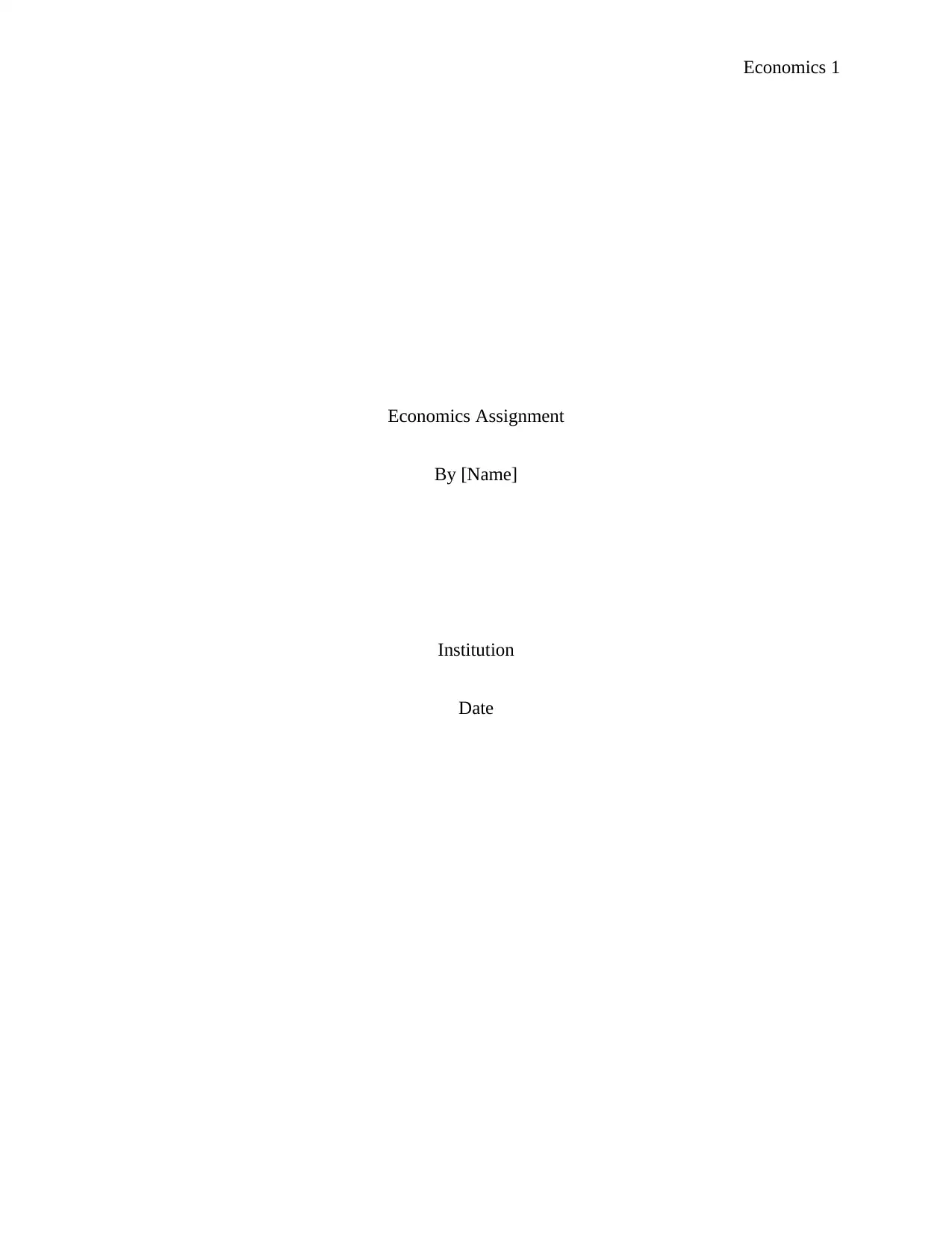
Economics 1
Economics Assignment
By [Name]
Institution
Date
Economics Assignment
By [Name]
Institution
Date
Paraphrase This Document
Need a fresh take? Get an instant paraphrase of this document with our AI Paraphraser
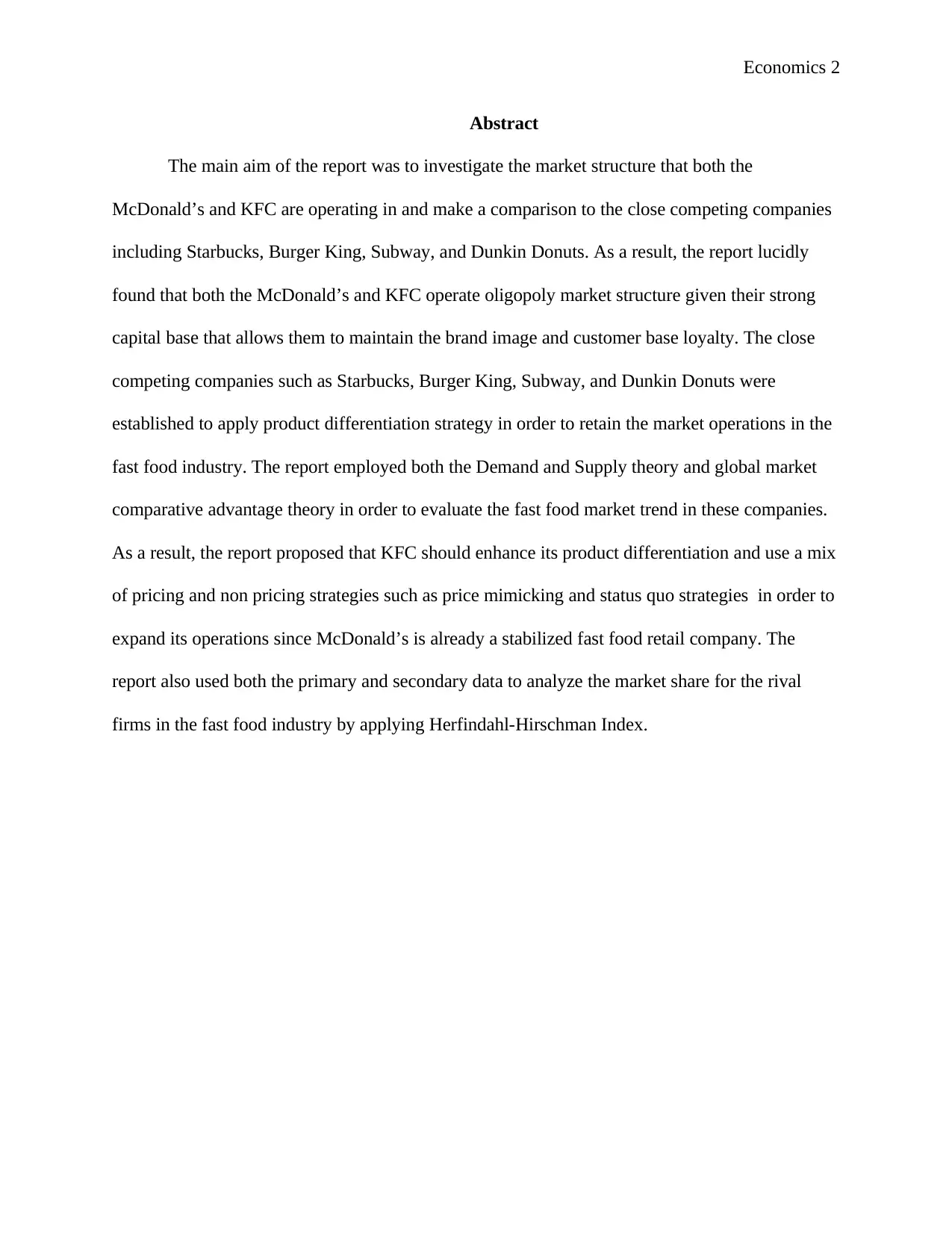
Economics 2
Abstract
The main aim of the report was to investigate the market structure that both the
McDonald’s and KFC are operating in and make a comparison to the close competing companies
including Starbucks, Burger King, Subway, and Dunkin Donuts. As a result, the report lucidly
found that both the McDonald’s and KFC operate oligopoly market structure given their strong
capital base that allows them to maintain the brand image and customer base loyalty. The close
competing companies such as Starbucks, Burger King, Subway, and Dunkin Donuts were
established to apply product differentiation strategy in order to retain the market operations in the
fast food industry. The report employed both the Demand and Supply theory and global market
comparative advantage theory in order to evaluate the fast food market trend in these companies.
As a result, the report proposed that KFC should enhance its product differentiation and use a mix
of pricing and non pricing strategies such as price mimicking and status quo strategies in order to
expand its operations since McDonald’s is already a stabilized fast food retail company. The
report also used both the primary and secondary data to analyze the market share for the rival
firms in the fast food industry by applying Herfindahl-Hirschman Index.
Abstract
The main aim of the report was to investigate the market structure that both the
McDonald’s and KFC are operating in and make a comparison to the close competing companies
including Starbucks, Burger King, Subway, and Dunkin Donuts. As a result, the report lucidly
found that both the McDonald’s and KFC operate oligopoly market structure given their strong
capital base that allows them to maintain the brand image and customer base loyalty. The close
competing companies such as Starbucks, Burger King, Subway, and Dunkin Donuts were
established to apply product differentiation strategy in order to retain the market operations in the
fast food industry. The report employed both the Demand and Supply theory and global market
comparative advantage theory in order to evaluate the fast food market trend in these companies.
As a result, the report proposed that KFC should enhance its product differentiation and use a mix
of pricing and non pricing strategies such as price mimicking and status quo strategies in order to
expand its operations since McDonald’s is already a stabilized fast food retail company. The
report also used both the primary and secondary data to analyze the market share for the rival
firms in the fast food industry by applying Herfindahl-Hirschman Index.
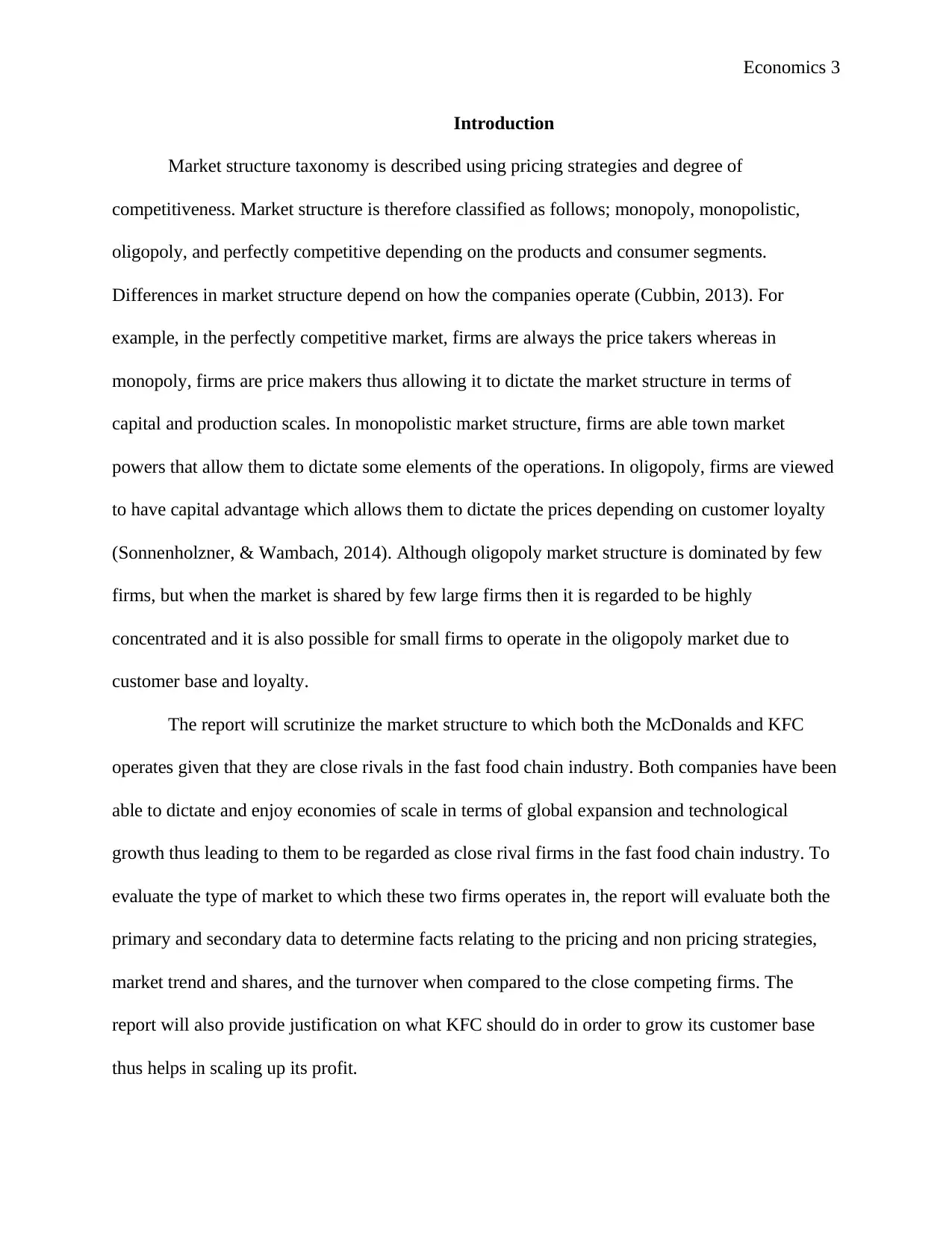
Economics 3
Introduction
Market structure taxonomy is described using pricing strategies and degree of
competitiveness. Market structure is therefore classified as follows; monopoly, monopolistic,
oligopoly, and perfectly competitive depending on the products and consumer segments.
Differences in market structure depend on how the companies operate (Cubbin, 2013). For
example, in the perfectly competitive market, firms are always the price takers whereas in
monopoly, firms are price makers thus allowing it to dictate the market structure in terms of
capital and production scales. In monopolistic market structure, firms are able town market
powers that allow them to dictate some elements of the operations. In oligopoly, firms are viewed
to have capital advantage which allows them to dictate the prices depending on customer loyalty
(Sonnenholzner, & Wambach, 2014). Although oligopoly market structure is dominated by few
firms, but when the market is shared by few large firms then it is regarded to be highly
concentrated and it is also possible for small firms to operate in the oligopoly market due to
customer base and loyalty.
The report will scrutinize the market structure to which both the McDonalds and KFC
operates given that they are close rivals in the fast food chain industry. Both companies have been
able to dictate and enjoy economies of scale in terms of global expansion and technological
growth thus leading to them to be regarded as close rival firms in the fast food chain industry. To
evaluate the type of market to which these two firms operates in, the report will evaluate both the
primary and secondary data to determine facts relating to the pricing and non pricing strategies,
market trend and shares, and the turnover when compared to the close competing firms. The
report will also provide justification on what KFC should do in order to grow its customer base
thus helps in scaling up its profit.
Introduction
Market structure taxonomy is described using pricing strategies and degree of
competitiveness. Market structure is therefore classified as follows; monopoly, monopolistic,
oligopoly, and perfectly competitive depending on the products and consumer segments.
Differences in market structure depend on how the companies operate (Cubbin, 2013). For
example, in the perfectly competitive market, firms are always the price takers whereas in
monopoly, firms are price makers thus allowing it to dictate the market structure in terms of
capital and production scales. In monopolistic market structure, firms are able town market
powers that allow them to dictate some elements of the operations. In oligopoly, firms are viewed
to have capital advantage which allows them to dictate the prices depending on customer loyalty
(Sonnenholzner, & Wambach, 2014). Although oligopoly market structure is dominated by few
firms, but when the market is shared by few large firms then it is regarded to be highly
concentrated and it is also possible for small firms to operate in the oligopoly market due to
customer base and loyalty.
The report will scrutinize the market structure to which both the McDonalds and KFC
operates given that they are close rivals in the fast food chain industry. Both companies have been
able to dictate and enjoy economies of scale in terms of global expansion and technological
growth thus leading to them to be regarded as close rival firms in the fast food chain industry. To
evaluate the type of market to which these two firms operates in, the report will evaluate both the
primary and secondary data to determine facts relating to the pricing and non pricing strategies,
market trend and shares, and the turnover when compared to the close competing firms. The
report will also provide justification on what KFC should do in order to grow its customer base
thus helps in scaling up its profit.
⊘ This is a preview!⊘
Do you want full access?
Subscribe today to unlock all pages.

Trusted by 1+ million students worldwide
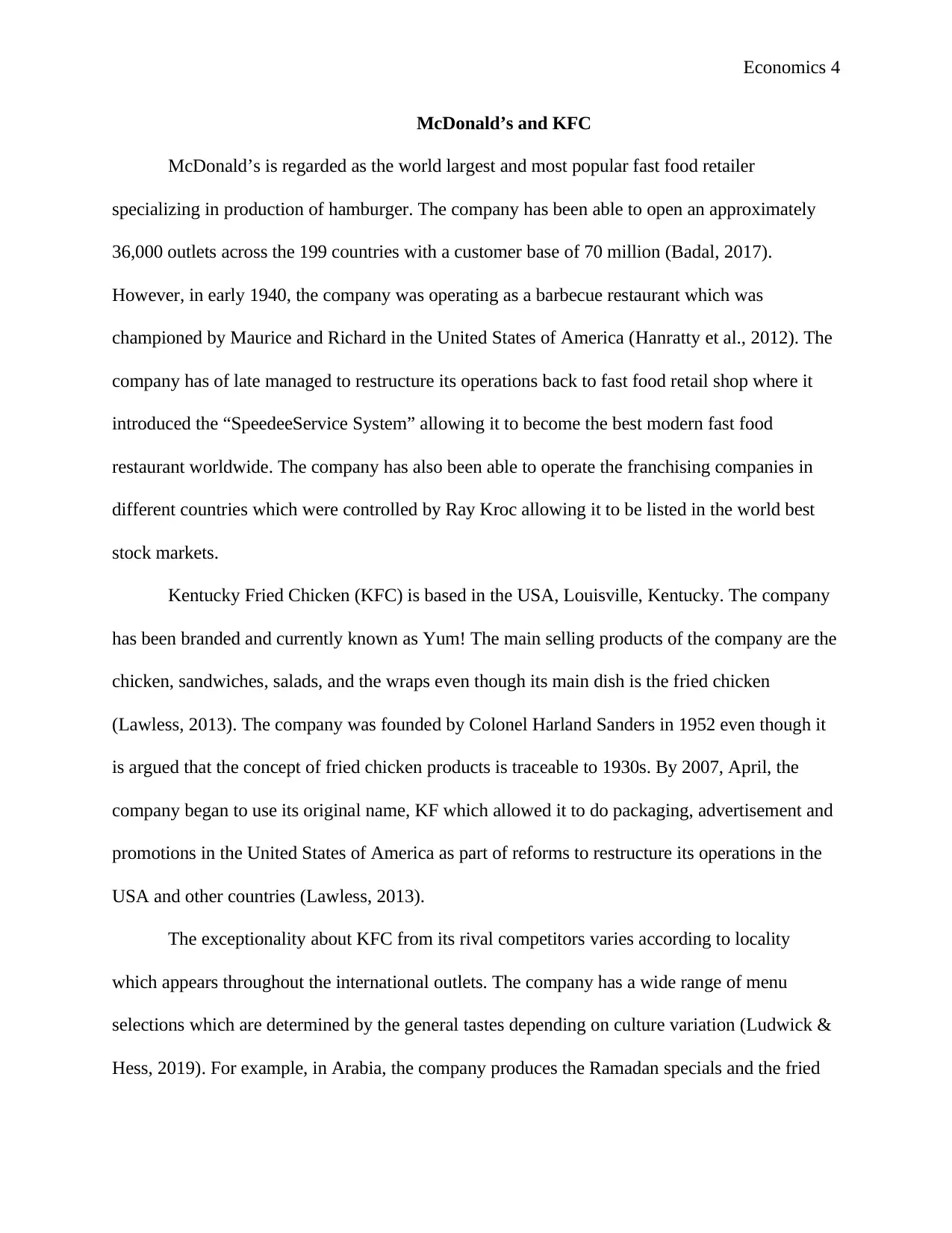
Economics 4
McDonald’s and KFC
McDonald’s is regarded as the world largest and most popular fast food retailer
specializing in production of hamburger. The company has been able to open an approximately
36,000 outlets across the 199 countries with a customer base of 70 million (Badal, 2017).
However, in early 1940, the company was operating as a barbecue restaurant which was
championed by Maurice and Richard in the United States of America (Hanratty et al., 2012). The
company has of late managed to restructure its operations back to fast food retail shop where it
introduced the “SpeedeeService System” allowing it to become the best modern fast food
restaurant worldwide. The company has also been able to operate the franchising companies in
different countries which were controlled by Ray Kroc allowing it to be listed in the world best
stock markets.
Kentucky Fried Chicken (KFC) is based in the USA, Louisville, Kentucky. The company
has been branded and currently known as Yum! The main selling products of the company are the
chicken, sandwiches, salads, and the wraps even though its main dish is the fried chicken
(Lawless, 2013). The company was founded by Colonel Harland Sanders in 1952 even though it
is argued that the concept of fried chicken products is traceable to 1930s. By 2007, April, the
company began to use its original name, KF which allowed it to do packaging, advertisement and
promotions in the United States of America as part of reforms to restructure its operations in the
USA and other countries (Lawless, 2013).
The exceptionality about KFC from its rival competitors varies according to locality
which appears throughout the international outlets. The company has a wide range of menu
selections which are determined by the general tastes depending on culture variation (Ludwick &
Hess, 2019). For example, in Arabia, the company produces the Ramadan specials and the fried
McDonald’s and KFC
McDonald’s is regarded as the world largest and most popular fast food retailer
specializing in production of hamburger. The company has been able to open an approximately
36,000 outlets across the 199 countries with a customer base of 70 million (Badal, 2017).
However, in early 1940, the company was operating as a barbecue restaurant which was
championed by Maurice and Richard in the United States of America (Hanratty et al., 2012). The
company has of late managed to restructure its operations back to fast food retail shop where it
introduced the “SpeedeeService System” allowing it to become the best modern fast food
restaurant worldwide. The company has also been able to operate the franchising companies in
different countries which were controlled by Ray Kroc allowing it to be listed in the world best
stock markets.
Kentucky Fried Chicken (KFC) is based in the USA, Louisville, Kentucky. The company
has been branded and currently known as Yum! The main selling products of the company are the
chicken, sandwiches, salads, and the wraps even though its main dish is the fried chicken
(Lawless, 2013). The company was founded by Colonel Harland Sanders in 1952 even though it
is argued that the concept of fried chicken products is traceable to 1930s. By 2007, April, the
company began to use its original name, KF which allowed it to do packaging, advertisement and
promotions in the United States of America as part of reforms to restructure its operations in the
USA and other countries (Lawless, 2013).
The exceptionality about KFC from its rival competitors varies according to locality
which appears throughout the international outlets. The company has a wide range of menu
selections which are determined by the general tastes depending on culture variation (Ludwick &
Hess, 2019). For example, in Arabia, the company produces the Ramadan specials and the fried
Paraphrase This Document
Need a fresh take? Get an instant paraphrase of this document with our AI Paraphraser
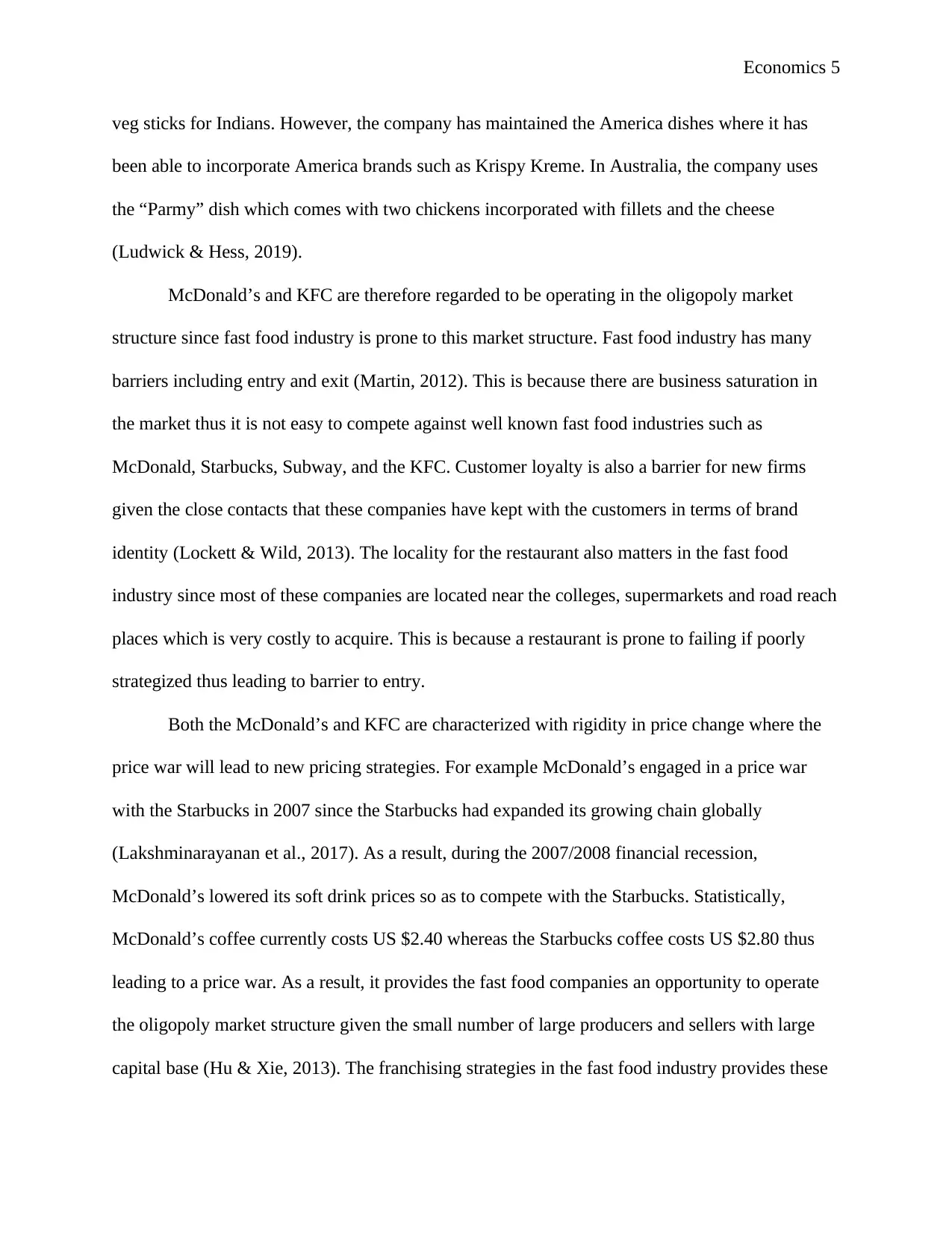
Economics 5
veg sticks for Indians. However, the company has maintained the America dishes where it has
been able to incorporate America brands such as Krispy Kreme. In Australia, the company uses
the “Parmy” dish which comes with two chickens incorporated with fillets and the cheese
(Ludwick & Hess, 2019).
McDonald’s and KFC are therefore regarded to be operating in the oligopoly market
structure since fast food industry is prone to this market structure. Fast food industry has many
barriers including entry and exit (Martin, 2012). This is because there are business saturation in
the market thus it is not easy to compete against well known fast food industries such as
McDonald, Starbucks, Subway, and the KFC. Customer loyalty is also a barrier for new firms
given the close contacts that these companies have kept with the customers in terms of brand
identity (Lockett & Wild, 2013). The locality for the restaurant also matters in the fast food
industry since most of these companies are located near the colleges, supermarkets and road reach
places which is very costly to acquire. This is because a restaurant is prone to failing if poorly
strategized thus leading to barrier to entry.
Both the McDonald’s and KFC are characterized with rigidity in price change where the
price war will lead to new pricing strategies. For example McDonald’s engaged in a price war
with the Starbucks in 2007 since the Starbucks had expanded its growing chain globally
(Lakshminarayanan et al., 2017). As a result, during the 2007/2008 financial recession,
McDonald’s lowered its soft drink prices so as to compete with the Starbucks. Statistically,
McDonald’s coffee currently costs US $2.40 whereas the Starbucks coffee costs US $2.80 thus
leading to a price war. As a result, it provides the fast food companies an opportunity to operate
the oligopoly market structure given the small number of large producers and sellers with large
capital base (Hu & Xie, 2013). The franchising strategies in the fast food industry provides these
veg sticks for Indians. However, the company has maintained the America dishes where it has
been able to incorporate America brands such as Krispy Kreme. In Australia, the company uses
the “Parmy” dish which comes with two chickens incorporated with fillets and the cheese
(Ludwick & Hess, 2019).
McDonald’s and KFC are therefore regarded to be operating in the oligopoly market
structure since fast food industry is prone to this market structure. Fast food industry has many
barriers including entry and exit (Martin, 2012). This is because there are business saturation in
the market thus it is not easy to compete against well known fast food industries such as
McDonald, Starbucks, Subway, and the KFC. Customer loyalty is also a barrier for new firms
given the close contacts that these companies have kept with the customers in terms of brand
identity (Lockett & Wild, 2013). The locality for the restaurant also matters in the fast food
industry since most of these companies are located near the colleges, supermarkets and road reach
places which is very costly to acquire. This is because a restaurant is prone to failing if poorly
strategized thus leading to barrier to entry.
Both the McDonald’s and KFC are characterized with rigidity in price change where the
price war will lead to new pricing strategies. For example McDonald’s engaged in a price war
with the Starbucks in 2007 since the Starbucks had expanded its growing chain globally
(Lakshminarayanan et al., 2017). As a result, during the 2007/2008 financial recession,
McDonald’s lowered its soft drink prices so as to compete with the Starbucks. Statistically,
McDonald’s coffee currently costs US $2.40 whereas the Starbucks coffee costs US $2.80 thus
leading to a price war. As a result, it provides the fast food companies an opportunity to operate
the oligopoly market structure given the small number of large producers and sellers with large
capital base (Hu & Xie, 2013). The franchising strategies in the fast food industry provides these
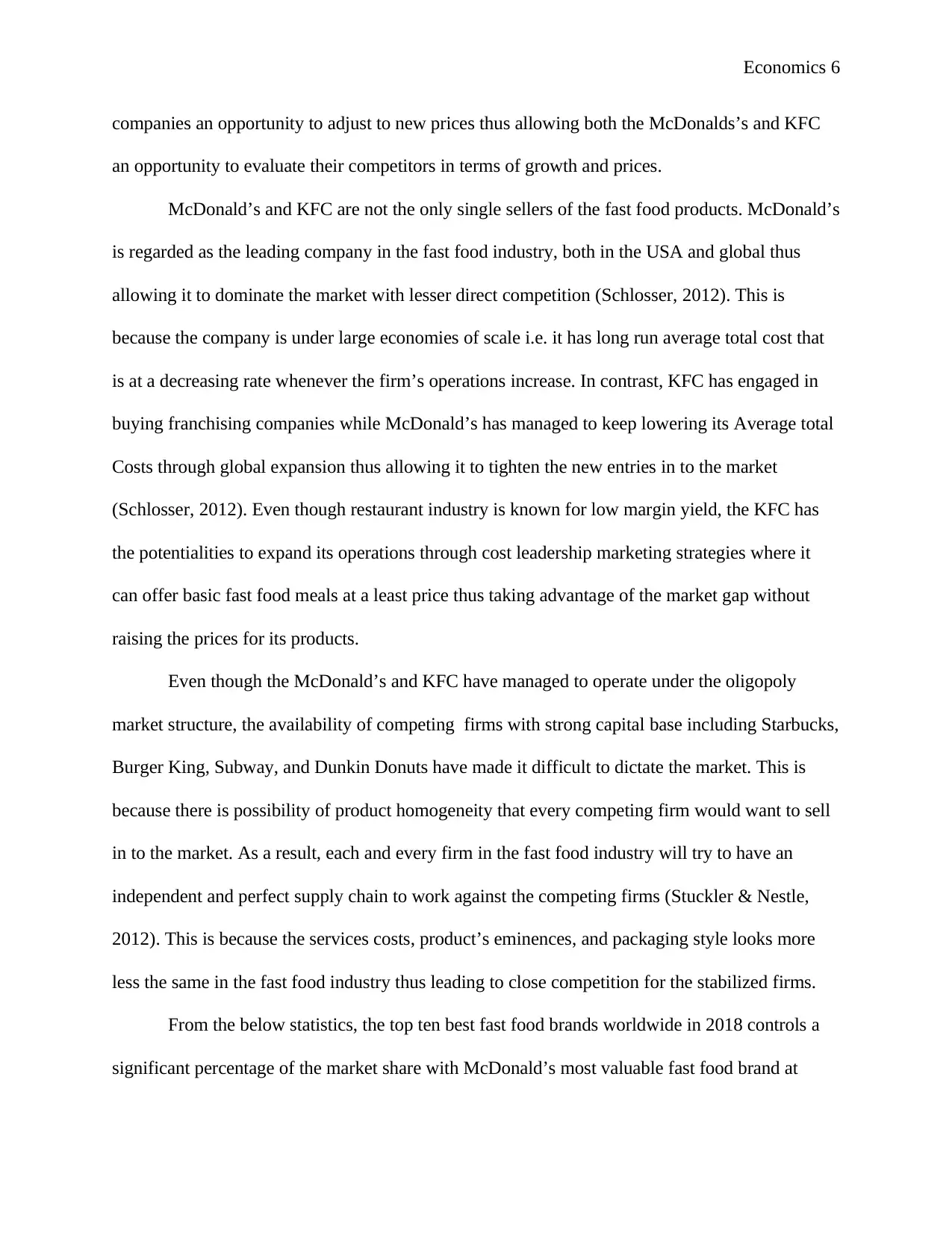
Economics 6
companies an opportunity to adjust to new prices thus allowing both the McDonalds’s and KFC
an opportunity to evaluate their competitors in terms of growth and prices.
McDonald’s and KFC are not the only single sellers of the fast food products. McDonald’s
is regarded as the leading company in the fast food industry, both in the USA and global thus
allowing it to dominate the market with lesser direct competition (Schlosser, 2012). This is
because the company is under large economies of scale i.e. it has long run average total cost that
is at a decreasing rate whenever the firm’s operations increase. In contrast, KFC has engaged in
buying franchising companies while McDonald’s has managed to keep lowering its Average total
Costs through global expansion thus allowing it to tighten the new entries in to the market
(Schlosser, 2012). Even though restaurant industry is known for low margin yield, the KFC has
the potentialities to expand its operations through cost leadership marketing strategies where it
can offer basic fast food meals at a least price thus taking advantage of the market gap without
raising the prices for its products.
Even though the McDonald’s and KFC have managed to operate under the oligopoly
market structure, the availability of competing firms with strong capital base including Starbucks,
Burger King, Subway, and Dunkin Donuts have made it difficult to dictate the market. This is
because there is possibility of product homogeneity that every competing firm would want to sell
in to the market. As a result, each and every firm in the fast food industry will try to have an
independent and perfect supply chain to work against the competing firms (Stuckler & Nestle,
2012). This is because the services costs, product’s eminences, and packaging style looks more
less the same in the fast food industry thus leading to close competition for the stabilized firms.
From the below statistics, the top ten best fast food brands worldwide in 2018 controls a
significant percentage of the market share with McDonald’s most valuable fast food brand at
companies an opportunity to adjust to new prices thus allowing both the McDonalds’s and KFC
an opportunity to evaluate their competitors in terms of growth and prices.
McDonald’s and KFC are not the only single sellers of the fast food products. McDonald’s
is regarded as the leading company in the fast food industry, both in the USA and global thus
allowing it to dominate the market with lesser direct competition (Schlosser, 2012). This is
because the company is under large economies of scale i.e. it has long run average total cost that
is at a decreasing rate whenever the firm’s operations increase. In contrast, KFC has engaged in
buying franchising companies while McDonald’s has managed to keep lowering its Average total
Costs through global expansion thus allowing it to tighten the new entries in to the market
(Schlosser, 2012). Even though restaurant industry is known for low margin yield, the KFC has
the potentialities to expand its operations through cost leadership marketing strategies where it
can offer basic fast food meals at a least price thus taking advantage of the market gap without
raising the prices for its products.
Even though the McDonald’s and KFC have managed to operate under the oligopoly
market structure, the availability of competing firms with strong capital base including Starbucks,
Burger King, Subway, and Dunkin Donuts have made it difficult to dictate the market. This is
because there is possibility of product homogeneity that every competing firm would want to sell
in to the market. As a result, each and every firm in the fast food industry will try to have an
independent and perfect supply chain to work against the competing firms (Stuckler & Nestle,
2012). This is because the services costs, product’s eminences, and packaging style looks more
less the same in the fast food industry thus leading to close competition for the stabilized firms.
From the below statistics, the top ten best fast food brands worldwide in 2018 controls a
significant percentage of the market share with McDonald’s most valuable fast food brand at
⊘ This is a preview!⊘
Do you want full access?
Subscribe today to unlock all pages.

Trusted by 1+ million students worldwide
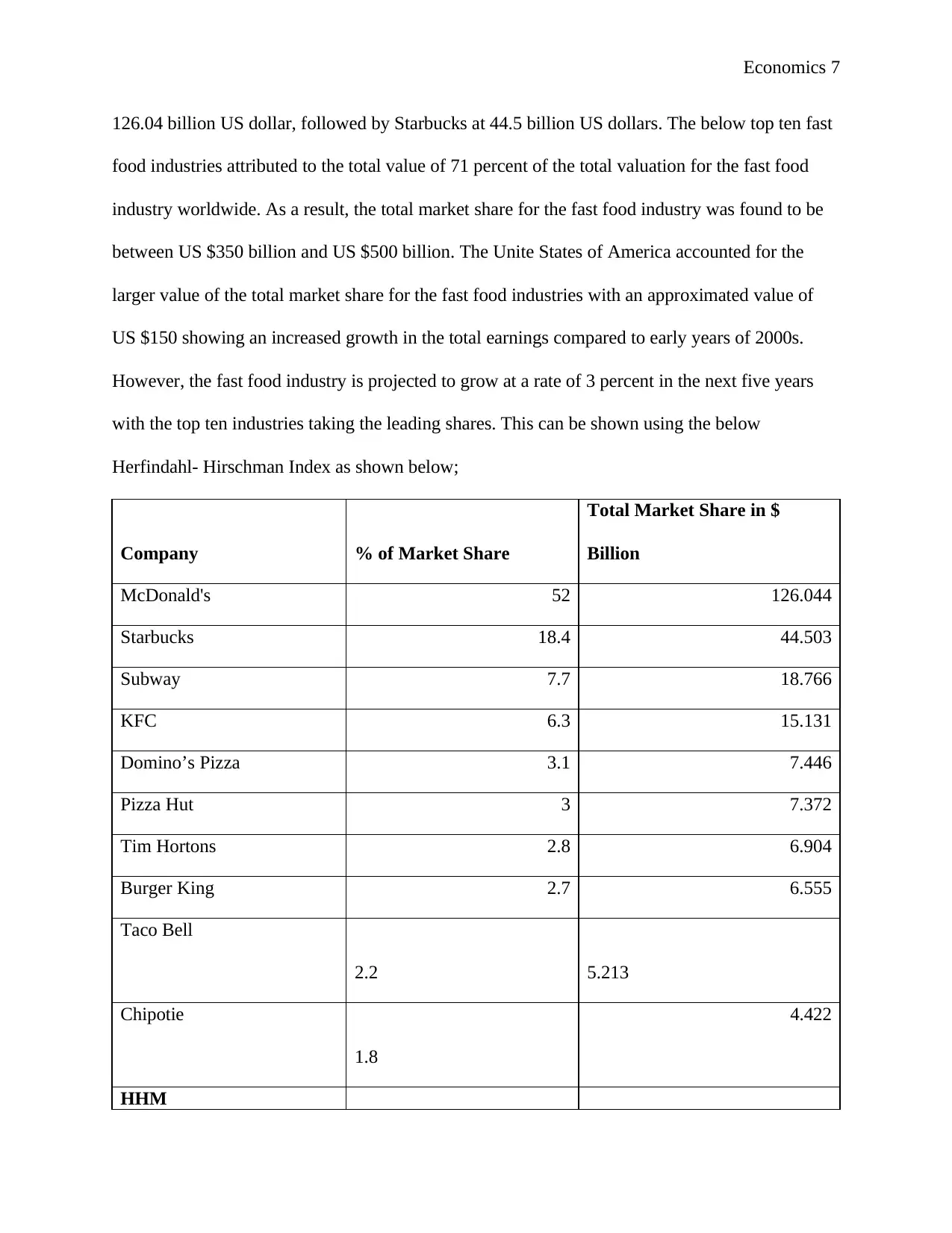
Economics 7
126.04 billion US dollar, followed by Starbucks at 44.5 billion US dollars. The below top ten fast
food industries attributed to the total value of 71 percent of the total valuation for the fast food
industry worldwide. As a result, the total market share for the fast food industry was found to be
between US $350 billion and US $500 billion. The Unite States of America accounted for the
larger value of the total market share for the fast food industries with an approximated value of
US $150 showing an increased growth in the total earnings compared to early years of 2000s.
However, the fast food industry is projected to grow at a rate of 3 percent in the next five years
with the top ten industries taking the leading shares. This can be shown using the below
Herfindahl- Hirschman Index as shown below;
Company % of Market Share
Total Market Share in $
Billion
McDonald's 52 126.044
Starbucks 18.4 44.503
Subway 7.7 18.766
KFC 6.3 15.131
Domino’s Pizza 3.1 7.446
Pizza Hut 3 7.372
Tim Hortons 2.8 6.904
Burger King 2.7 6.555
Taco Bell
2.2 5.213
Chipotie
1.8
4.422
HHM
126.04 billion US dollar, followed by Starbucks at 44.5 billion US dollars. The below top ten fast
food industries attributed to the total value of 71 percent of the total valuation for the fast food
industry worldwide. As a result, the total market share for the fast food industry was found to be
between US $350 billion and US $500 billion. The Unite States of America accounted for the
larger value of the total market share for the fast food industries with an approximated value of
US $150 showing an increased growth in the total earnings compared to early years of 2000s.
However, the fast food industry is projected to grow at a rate of 3 percent in the next five years
with the top ten industries taking the leading shares. This can be shown using the below
Herfindahl- Hirschman Index as shown below;
Company % of Market Share
Total Market Share in $
Billion
McDonald's 52 126.044
Starbucks 18.4 44.503
Subway 7.7 18.766
KFC 6.3 15.131
Domino’s Pizza 3.1 7.446
Pizza Hut 3 7.372
Tim Hortons 2.8 6.904
Burger King 2.7 6.555
Taco Bell
2.2 5.213
Chipotie
1.8
4.422
HHM
Paraphrase This Document
Need a fresh take? Get an instant paraphrase of this document with our AI Paraphraser
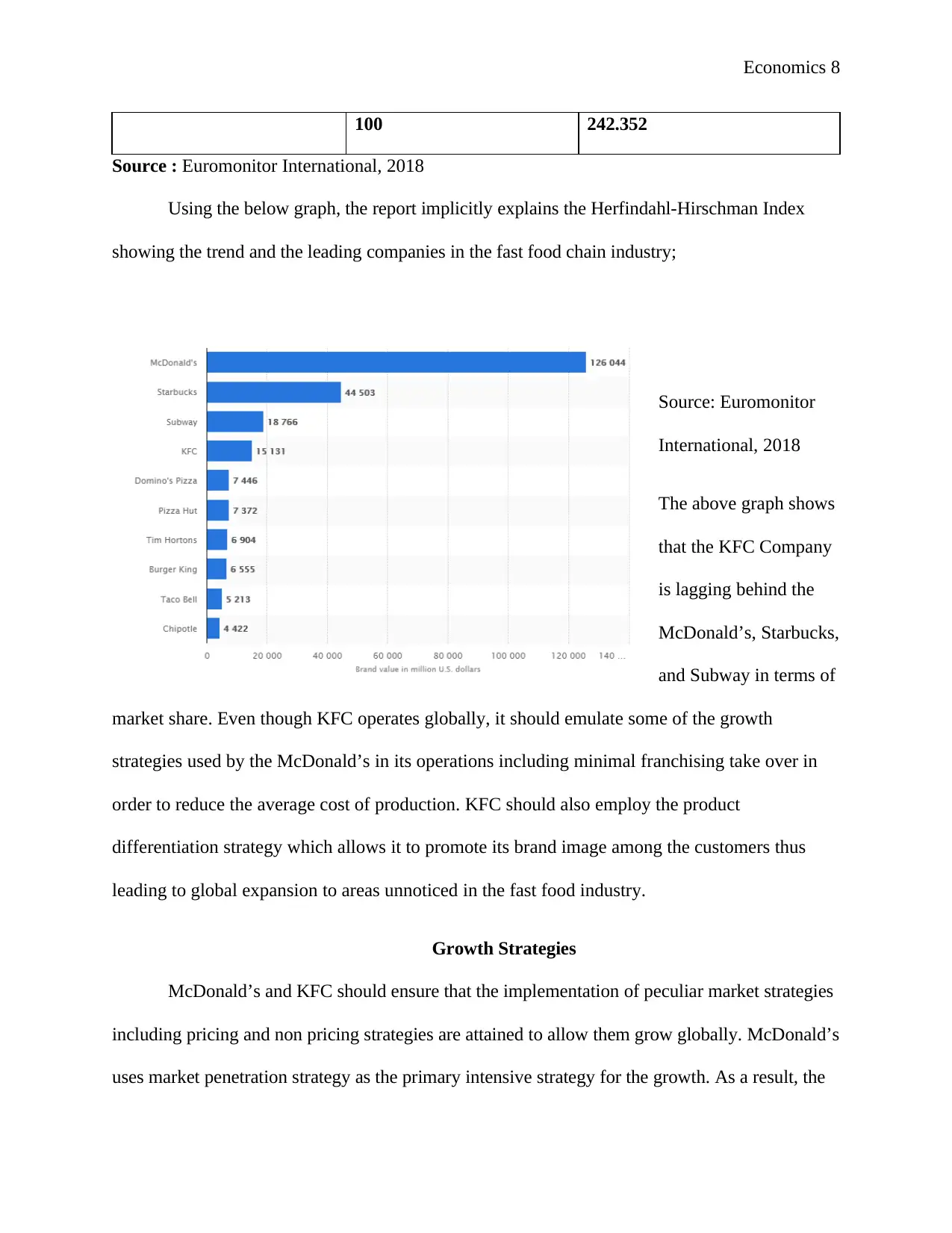
Economics 8
100 242.352
Source : Euromonitor International, 2018
Using the below graph, the report implicitly explains the Herfindahl-Hirschman Index
showing the trend and the leading companies in the fast food chain industry;
Source: Euromonitor
International, 2018
The above graph shows
that the KFC Company
is lagging behind the
McDonald’s, Starbucks,
and Subway in terms of
market share. Even though KFC operates globally, it should emulate some of the growth
strategies used by the McDonald’s in its operations including minimal franchising take over in
order to reduce the average cost of production. KFC should also employ the product
differentiation strategy which allows it to promote its brand image among the customers thus
leading to global expansion to areas unnoticed in the fast food industry.
Growth Strategies
McDonald’s and KFC should ensure that the implementation of peculiar market strategies
including pricing and non pricing strategies are attained to allow them grow globally. McDonald’s
uses market penetration strategy as the primary intensive strategy for the growth. As a result, the
100 242.352
Source : Euromonitor International, 2018
Using the below graph, the report implicitly explains the Herfindahl-Hirschman Index
showing the trend and the leading companies in the fast food chain industry;
Source: Euromonitor
International, 2018
The above graph shows
that the KFC Company
is lagging behind the
McDonald’s, Starbucks,
and Subway in terms of
market share. Even though KFC operates globally, it should emulate some of the growth
strategies used by the McDonald’s in its operations including minimal franchising take over in
order to reduce the average cost of production. KFC should also employ the product
differentiation strategy which allows it to promote its brand image among the customers thus
leading to global expansion to areas unnoticed in the fast food industry.
Growth Strategies
McDonald’s and KFC should ensure that the implementation of peculiar market strategies
including pricing and non pricing strategies are attained to allow them grow globally. McDonald’s
uses market penetration strategy as the primary intensive strategy for the growth. As a result, the
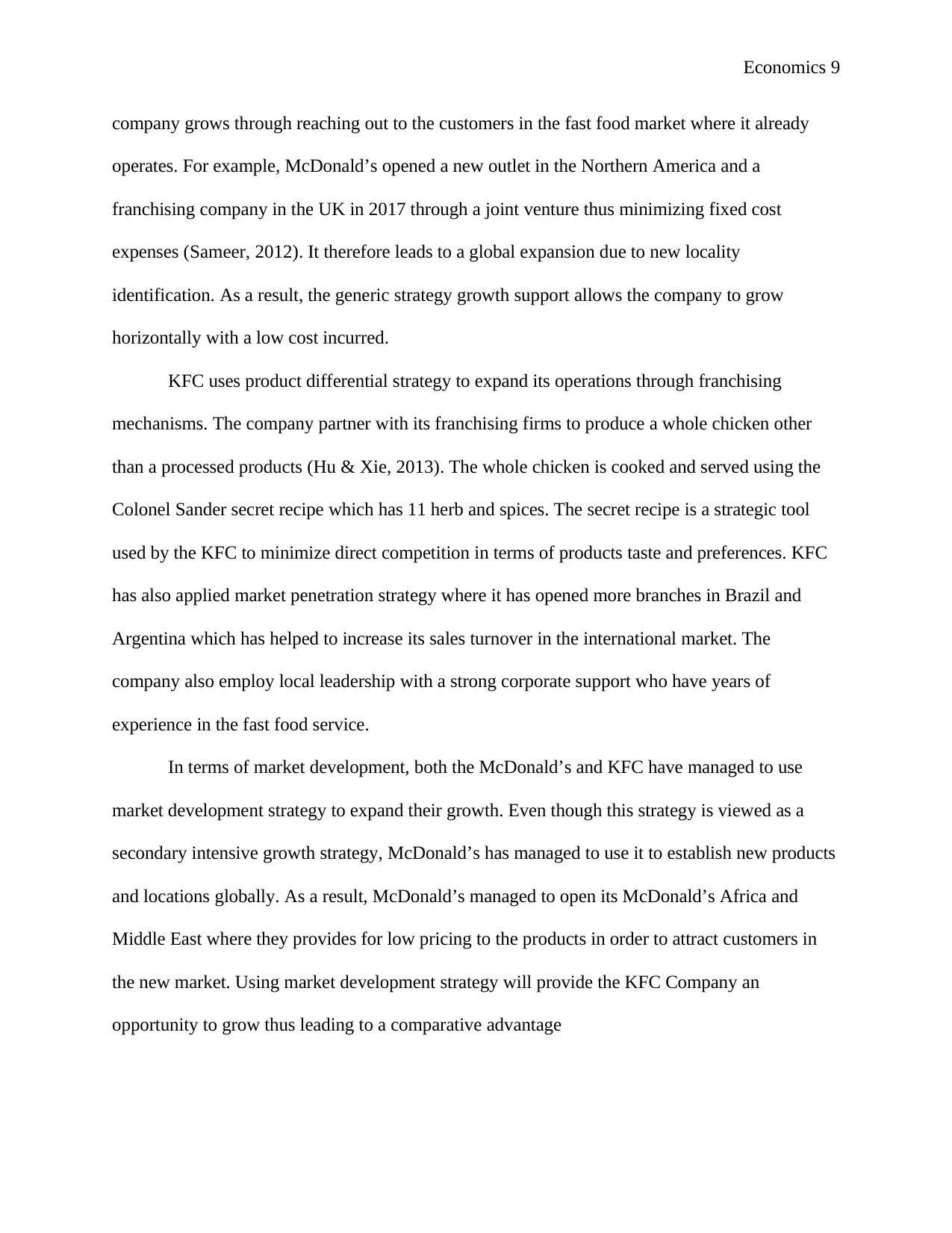
Economics 9
company grows through reaching out to the customers in the fast food market where it already
operates. For example, McDonald’s opened a new outlet in the Northern America and a
franchising company in the UK in 2017 through a joint venture thus minimizing fixed cost
expenses (Sameer, 2012). It therefore leads to a global expansion due to new locality
identification. As a result, the generic strategy growth support allows the company to grow
horizontally with a low cost incurred.
KFC uses product differential strategy to expand its operations through franchising
mechanisms. The company partner with its franchising firms to produce a whole chicken other
than a processed products (Hu & Xie, 2013). The whole chicken is cooked and served using the
Colonel Sander secret recipe which has 11 herb and spices. The secret recipe is a strategic tool
used by the KFC to minimize direct competition in terms of products taste and preferences. KFC
has also applied market penetration strategy where it has opened more branches in Brazil and
Argentina which has helped to increase its sales turnover in the international market. The
company also employ local leadership with a strong corporate support who have years of
experience in the fast food service.
In terms of market development, both the McDonald’s and KFC have managed to use
market development strategy to expand their growth. Even though this strategy is viewed as a
secondary intensive growth strategy, McDonald’s has managed to use it to establish new products
and locations globally. As a result, McDonald’s managed to open its McDonald’s Africa and
Middle East where they provides for low pricing to the products in order to attract customers in
the new market. Using market development strategy will provide the KFC Company an
opportunity to grow thus leading to a comparative advantage
company grows through reaching out to the customers in the fast food market where it already
operates. For example, McDonald’s opened a new outlet in the Northern America and a
franchising company in the UK in 2017 through a joint venture thus minimizing fixed cost
expenses (Sameer, 2012). It therefore leads to a global expansion due to new locality
identification. As a result, the generic strategy growth support allows the company to grow
horizontally with a low cost incurred.
KFC uses product differential strategy to expand its operations through franchising
mechanisms. The company partner with its franchising firms to produce a whole chicken other
than a processed products (Hu & Xie, 2013). The whole chicken is cooked and served using the
Colonel Sander secret recipe which has 11 herb and spices. The secret recipe is a strategic tool
used by the KFC to minimize direct competition in terms of products taste and preferences. KFC
has also applied market penetration strategy where it has opened more branches in Brazil and
Argentina which has helped to increase its sales turnover in the international market. The
company also employ local leadership with a strong corporate support who have years of
experience in the fast food service.
In terms of market development, both the McDonald’s and KFC have managed to use
market development strategy to expand their growth. Even though this strategy is viewed as a
secondary intensive growth strategy, McDonald’s has managed to use it to establish new products
and locations globally. As a result, McDonald’s managed to open its McDonald’s Africa and
Middle East where they provides for low pricing to the products in order to attract customers in
the new market. Using market development strategy will provide the KFC Company an
opportunity to grow thus leading to a comparative advantage
⊘ This is a preview!⊘
Do you want full access?
Subscribe today to unlock all pages.

Trusted by 1+ million students worldwide
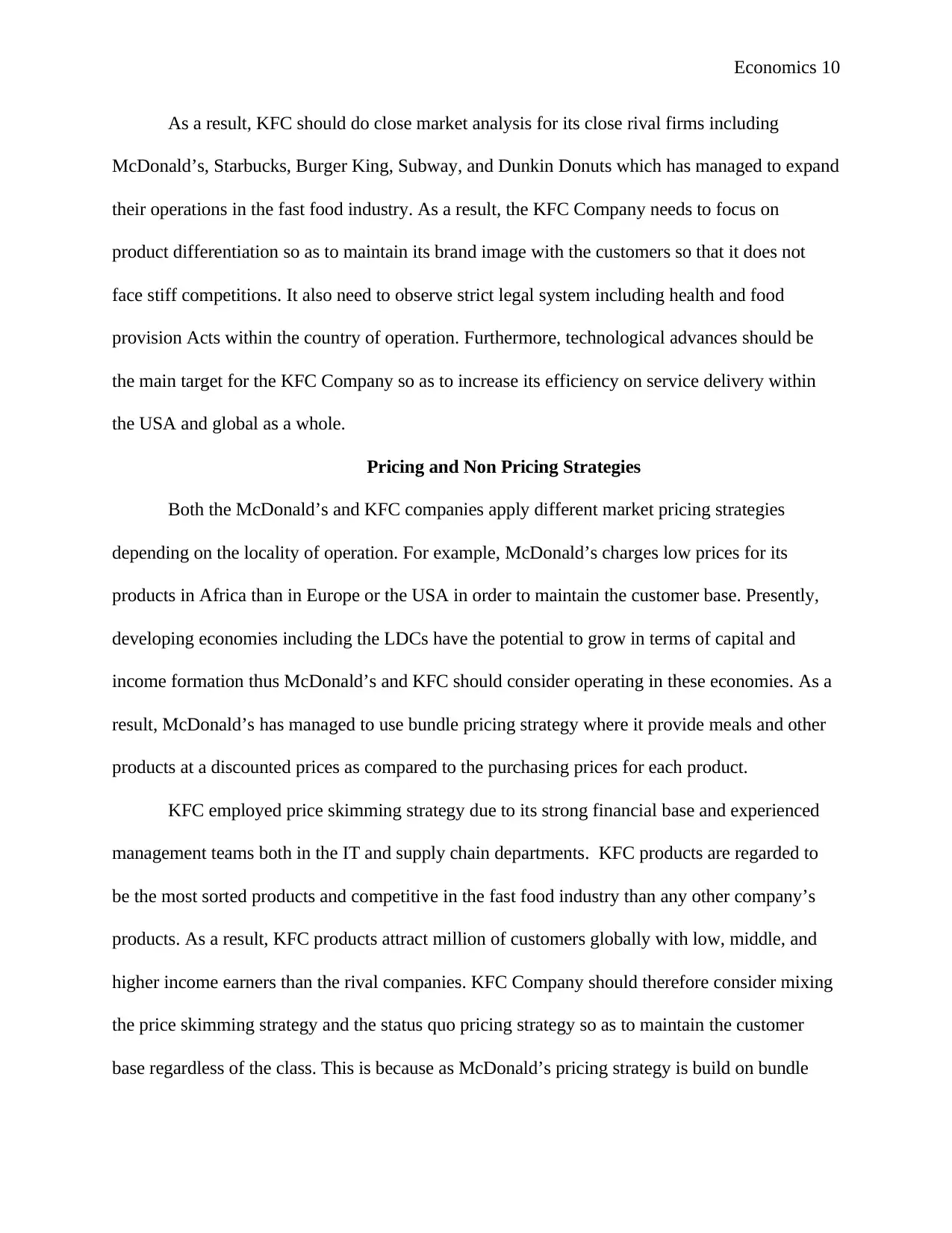
Economics 10
As a result, KFC should do close market analysis for its close rival firms including
McDonald’s, Starbucks, Burger King, Subway, and Dunkin Donuts which has managed to expand
their operations in the fast food industry. As a result, the KFC Company needs to focus on
product differentiation so as to maintain its brand image with the customers so that it does not
face stiff competitions. It also need to observe strict legal system including health and food
provision Acts within the country of operation. Furthermore, technological advances should be
the main target for the KFC Company so as to increase its efficiency on service delivery within
the USA and global as a whole.
Pricing and Non Pricing Strategies
Both the McDonald’s and KFC companies apply different market pricing strategies
depending on the locality of operation. For example, McDonald’s charges low prices for its
products in Africa than in Europe or the USA in order to maintain the customer base. Presently,
developing economies including the LDCs have the potential to grow in terms of capital and
income formation thus McDonald’s and KFC should consider operating in these economies. As a
result, McDonald’s has managed to use bundle pricing strategy where it provide meals and other
products at a discounted prices as compared to the purchasing prices for each product.
KFC employed price skimming strategy due to its strong financial base and experienced
management teams both in the IT and supply chain departments. KFC products are regarded to
be the most sorted products and competitive in the fast food industry than any other company’s
products. As a result, KFC products attract million of customers globally with low, middle, and
higher income earners than the rival companies. KFC Company should therefore consider mixing
the price skimming strategy and the status quo pricing strategy so as to maintain the customer
base regardless of the class. This is because as McDonald’s pricing strategy is build on bundle
As a result, KFC should do close market analysis for its close rival firms including
McDonald’s, Starbucks, Burger King, Subway, and Dunkin Donuts which has managed to expand
their operations in the fast food industry. As a result, the KFC Company needs to focus on
product differentiation so as to maintain its brand image with the customers so that it does not
face stiff competitions. It also need to observe strict legal system including health and food
provision Acts within the country of operation. Furthermore, technological advances should be
the main target for the KFC Company so as to increase its efficiency on service delivery within
the USA and global as a whole.
Pricing and Non Pricing Strategies
Both the McDonald’s and KFC companies apply different market pricing strategies
depending on the locality of operation. For example, McDonald’s charges low prices for its
products in Africa than in Europe or the USA in order to maintain the customer base. Presently,
developing economies including the LDCs have the potential to grow in terms of capital and
income formation thus McDonald’s and KFC should consider operating in these economies. As a
result, McDonald’s has managed to use bundle pricing strategy where it provide meals and other
products at a discounted prices as compared to the purchasing prices for each product.
KFC employed price skimming strategy due to its strong financial base and experienced
management teams both in the IT and supply chain departments. KFC products are regarded to
be the most sorted products and competitive in the fast food industry than any other company’s
products. As a result, KFC products attract million of customers globally with low, middle, and
higher income earners than the rival companies. KFC Company should therefore consider mixing
the price skimming strategy and the status quo pricing strategy so as to maintain the customer
base regardless of the class. This is because as McDonald’s pricing strategy is build on bundle
Paraphrase This Document
Need a fresh take? Get an instant paraphrase of this document with our AI Paraphraser
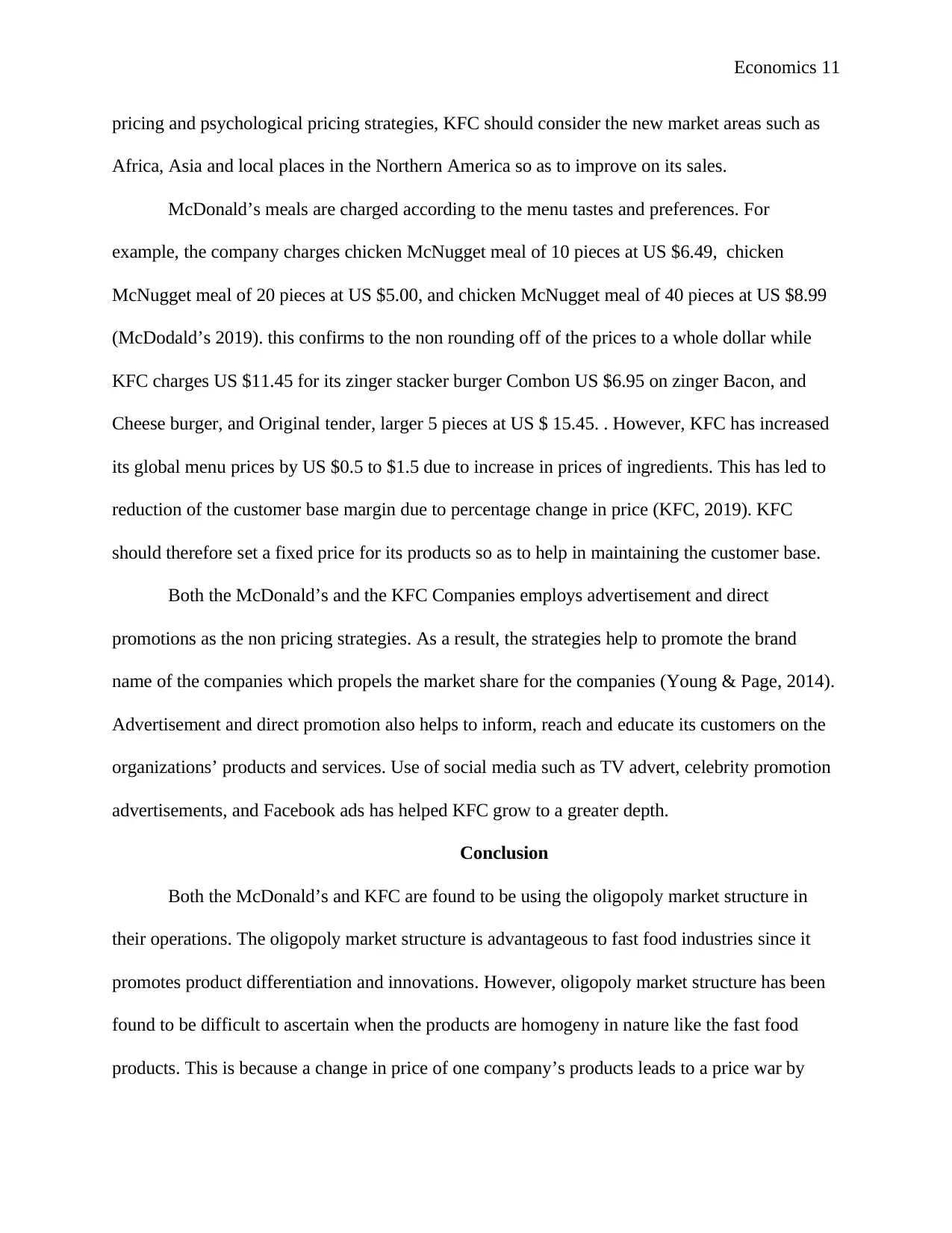
Economics 11
pricing and psychological pricing strategies, KFC should consider the new market areas such as
Africa, Asia and local places in the Northern America so as to improve on its sales.
McDonald’s meals are charged according to the menu tastes and preferences. For
example, the company charges chicken McNugget meal of 10 pieces at US $6.49, chicken
McNugget meal of 20 pieces at US $5.00, and chicken McNugget meal of 40 pieces at US $8.99
(McDodald’s 2019). this confirms to the non rounding off of the prices to a whole dollar while
KFC charges US $11.45 for its zinger stacker burger Combon US $6.95 on zinger Bacon, and
Cheese burger, and Original tender, larger 5 pieces at US $ 15.45. . However, KFC has increased
its global menu prices by US $0.5 to $1.5 due to increase in prices of ingredients. This has led to
reduction of the customer base margin due to percentage change in price (KFC, 2019). KFC
should therefore set a fixed price for its products so as to help in maintaining the customer base.
Both the McDonald’s and the KFC Companies employs advertisement and direct
promotions as the non pricing strategies. As a result, the strategies help to promote the brand
name of the companies which propels the market share for the companies (Young & Page, 2014).
Advertisement and direct promotion also helps to inform, reach and educate its customers on the
organizations’ products and services. Use of social media such as TV advert, celebrity promotion
advertisements, and Facebook ads has helped KFC grow to a greater depth.
Conclusion
Both the McDonald’s and KFC are found to be using the oligopoly market structure in
their operations. The oligopoly market structure is advantageous to fast food industries since it
promotes product differentiation and innovations. However, oligopoly market structure has been
found to be difficult to ascertain when the products are homogeny in nature like the fast food
products. This is because a change in price of one company’s products leads to a price war by
pricing and psychological pricing strategies, KFC should consider the new market areas such as
Africa, Asia and local places in the Northern America so as to improve on its sales.
McDonald’s meals are charged according to the menu tastes and preferences. For
example, the company charges chicken McNugget meal of 10 pieces at US $6.49, chicken
McNugget meal of 20 pieces at US $5.00, and chicken McNugget meal of 40 pieces at US $8.99
(McDodald’s 2019). this confirms to the non rounding off of the prices to a whole dollar while
KFC charges US $11.45 for its zinger stacker burger Combon US $6.95 on zinger Bacon, and
Cheese burger, and Original tender, larger 5 pieces at US $ 15.45. . However, KFC has increased
its global menu prices by US $0.5 to $1.5 due to increase in prices of ingredients. This has led to
reduction of the customer base margin due to percentage change in price (KFC, 2019). KFC
should therefore set a fixed price for its products so as to help in maintaining the customer base.
Both the McDonald’s and the KFC Companies employs advertisement and direct
promotions as the non pricing strategies. As a result, the strategies help to promote the brand
name of the companies which propels the market share for the companies (Young & Page, 2014).
Advertisement and direct promotion also helps to inform, reach and educate its customers on the
organizations’ products and services. Use of social media such as TV advert, celebrity promotion
advertisements, and Facebook ads has helped KFC grow to a greater depth.
Conclusion
Both the McDonald’s and KFC are found to be using the oligopoly market structure in
their operations. The oligopoly market structure is advantageous to fast food industries since it
promotes product differentiation and innovations. However, oligopoly market structure has been
found to be difficult to ascertain when the products are homogeny in nature like the fast food
products. This is because a change in price of one company’s products leads to a price war by

Economics 12
other companies thus leading to retaliation which is unproductive in nature. KFC company was
found to be least expanded as compared to McDonald’s even though they are close rival in the
fast food chain industry. Close competing fast food companies including Starbucks, Subway,
Burger King, and Dunkin Donuts were found to have a strong capital base that serves as a threat
to both the McDonald’s and KFC. However, the pricing and non pricing strategies employed by
KFC was found to be viable in the long run such that it will be able to overtake its close
competitors if properly applied in its production. As a result, KFC is destined to both capital and
customer growth if it takes in to consideration the analytical recommendations that the report
proposed including in the growth strategy and pricing and non pricing strategies in the global fast
food market.
other companies thus leading to retaliation which is unproductive in nature. KFC company was
found to be least expanded as compared to McDonald’s even though they are close rival in the
fast food chain industry. Close competing fast food companies including Starbucks, Subway,
Burger King, and Dunkin Donuts were found to have a strong capital base that serves as a threat
to both the McDonald’s and KFC. However, the pricing and non pricing strategies employed by
KFC was found to be viable in the long run such that it will be able to overtake its close
competitors if properly applied in its production. As a result, KFC is destined to both capital and
customer growth if it takes in to consideration the analytical recommendations that the report
proposed including in the growth strategy and pricing and non pricing strategies in the global fast
food market.
⊘ This is a preview!⊘
Do you want full access?
Subscribe today to unlock all pages.

Trusted by 1+ million students worldwide
1 out of 14
Related Documents
Your All-in-One AI-Powered Toolkit for Academic Success.
+13062052269
info@desklib.com
Available 24*7 on WhatsApp / Email
![[object Object]](/_next/static/media/star-bottom.7253800d.svg)
Unlock your academic potential
Copyright © 2020–2025 A2Z Services. All Rights Reserved. Developed and managed by ZUCOL.





